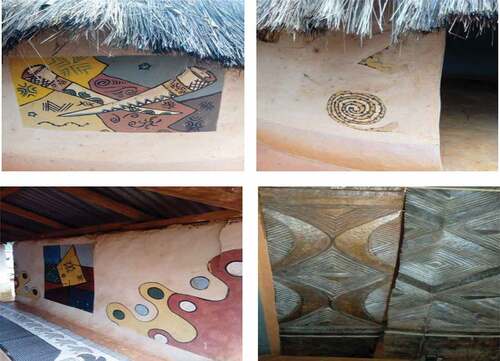A quick observation of most African villages and even towns reveals the enduring presence of traditional architectural designs, particularly indigenous mud huts. These structures embody a sustainability ethos, with earth buildings of various types serving every economic and social stratum across the globe over time.
Historically, Africans have thrived in shelters less advanced than those prevalent on the continent today. These buildings served purposes beyond mere shelter, reflecting early human adaptation to the natural environment by utilizing locally available materials for comfortable and secure dwellings against harsh weather and wildlife.
Housing practices are deeply rooted in culture and tradition, shaping African history through the ages. Traditional dwellings constitute a crucial aspect of the people’s cultural and historical identity. Basic human needs encompass shelter, food, and clothing, and traditional mud huts not only provide housing but also serve as storage for food, crops, and livestock. Additionally, in communities where hut construction is a livelihood, it provides a source of income for the builders.
Nigeria boasts diverse landscapes and numerous ethnic groups. Indigenous mud huts still dot various parts of the country, predominantly in rural areas. These huts are integral to the lives, environment, and cultural heritage of the people, offering shelter and natural cooling to residents. They continue to be constructed in regions like the northern and south-eastern parts of Nigeria. Moreover, their presence holds political significance, as some traditional leaders inhabit or maintain these mud huts built by their ancestors, honoring culture, tradition, and heritage.
Furthermore, the intricate designs and paintings adorning the walls of these huts carry historical, mystical, and philosophical significance. The shapes and styles of the huts serve as indicators of the status of titled men and chiefs within a community. African art embodies religious concepts in various forms such as wood, stools, calabashes, stones, sticks, pots, handicrafts, domestic animals, and human figures, including masks and carvings on wood, ivory, and stone.
Within the realm of traditional mud huts, the special hut known as “obi” in Igbo cosmology holds exceptional power and deep symbolism, reflecting the authority and status of the eldest or first man in a compound. Mud wall builders strive to maintain their reputations, earning recognition as the finest wall builders in neighboring villages, akin to safeguarding their brand in contemporary commercial terms. African women also play a significant role once the men have completed the construction of mud huts. Wives undertake the decoration of the houses after construction, meticulously plastering the walls with a mixture of mud and dung and often adding color with natural dyes.
When comparing African culture to Western culture, African aesthetics distinctly reflect class and traditional values. Indigenous living structures in southeast Nigeria, exemplified by mud huts, along with their designs, aesthetics, and historical significance, encapsulate the way of life of the people. Signs and symbols are integral to the ecosystem of certain villages in Igbo land.
Availability of Materials and Building Methods for Mud Huts
The design and shape of mud huts are often influenced by the tribes and communities they belong to, as well as the prevailing natural conditions and climate. Materials for constructing these huts, such as water, mud, thatch, sticks, bamboo, and palm fronds, are usually readily available and are typically not purchased, especially by indigenous people. Mud huts can vary in shape, being either rectangular, square, or round.
Obtaining the right texture of mud involves digging deep into the ground to procure fresh and pure red mud, which is considered the best quality as it binds well when kneaded. This mud is then sieved to remove any impurities and mixed with a small amount of water before being gradually molded around a marked-out foundation to form the structure of the hut.
Alternatively, mud blocks of uniform size can be meticulously molded and either fired or sun-dried outdoors before being stacked atop each other to create more durable and long-lasting huts. Sticks, stones, and mud are often used to create a solid foundation, with bamboo serving as a framework for plastering the mud onto. The interior floor is typically smoothed by women and children to enhance its appearance and provide a cooling effect.
Traditionally, roofs are constructed using palm fronds or thatch, though the trend is shifting towards the use of zinc roofing with the advancement of civilization. Despite the modernization of architectural practices, there are diverse perspectives regarding those who continue to reside in traditional mud huts amidst the ongoing changes in society.
The utilization of materials sourced from the natural environment for constructing the huts showcases originality, quality, innovation, style, and taste.

Forms and Ideology of Architectural Mud Houses
The shapes and configurations of traditional mud houses in Nigeria are influenced by factors such as landscape, geographic location, climate, and socio-cultural context. These huts exhibit diverse shapes and styles, often adorned with intricate drawings and inscriptions on their walls. The primary material used for molding the walls of these structures is a specific type of soil known as clay soil or earthenware, which is shaped by hand. A more refined technique involving the heating of mud blocks enhances the beauty and durability of mud huts.
In regions like Igbo land, mud huts are typically molded into square, rectangular, or round shapes. In contrast, in the northern parts of the country, such as Sokoto and Kano, round huts are prevalent, often featuring flat mud roofs to combat the intense heat and sunlight. Thatch and palm fronds are commonly used materials for roofing in the southeast, while fences and entrance gates are constructed from similar materials to provide security and delineate boundaries.
Despite their reliance on materials like mud and thatch, which are less durable compared to modern construction materials like blocks and zinc, traditional huts are maintained periodically by women and children. They offer shelter and protection from the elements and wildlife, including protection from cold, sun exposure, and wild animals.
Many traditional huts incorporate local dye materials such as uli, a natural dye derived from a tree of the same name, for decorative purposes. Decorative arts, including Igbo art and drawings, whether on the body or on mud walls, reflect philosophical, ideological, and belief systems, embodying tangible and intangible cultural elements.
Women often exhibit skill in using uli for personal adornment and wall decoration, while Nsibidi designs, symbolic motifs, and inscriptions convey the beliefs and social status of the inhabitants. Nsibidi, an ideographic script containing abstract drawings representing thoughts, objects, animals, etc., is unique to the culture and may be challenging for outsiders to interpret without proper knowledge.

The illustrations adorning mud huts are often inspired by daily objects present in the environment, such as lizards, birds, the sun, the moon, and palm trees, among others. These symbols serve a purpose, acting as reminders of their significance in the lives of the inhabitants. Both men and women may partake in the design process, though in many cases, women are responsible for common drawings, while deeper spiritual depictions may be handled by men.
Additionally, the maintenance of mud floors and internal walls to maintain their shine and coolness is typically the responsibility of women and children. This task involves periodic re-plastering with mud and water. However, major repairs involving exterior walls or roofs are typically undertaken by men.



